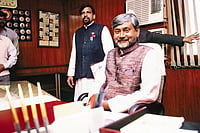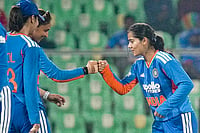WHAT all of us should find rejoicing in the sad event of Sir Donald Bradman's death is that we were privileged to have seen him, heard him, and lived in the same century as him. The Don was not just the world's greatest batsman, he was also the world's greatest cricketer. Bradman showed that beauty is greatness with a difference—it is not only in the eyes of the beholder. And most likely, Bradman wasn't just the world's greatest cricketer, he was the world's greatest athlete—past, present or future.
This may seem normal exaggeration at the passing of an icon. It's not; my major regret is that I wasn't able to finish my research on establishing who is/was the world's greatest athlete or sportsperson while Bradman was still alive. But how does one establish that Bradman, or anybody else, was the world's greatest sportsman? How can one compare a Michael Jordan to a Tiger Woods to a Bradman?
The method to evaluate athletes within and across sports is identical—and simple. Pick an index of brilliance—batting average for a batsman and runs per wicket for a bowler. The best batsman then is Sir Donald Bradman (99.94) and the best bowler: Sid Barnes (16.43 runs per wicket). But who is the better cricketer, Bradman or Barnes? Clearly Bradman, because his average is an incredible 64 per cent more than the next best batting average, that of the great South African Graeme Pollock (60.97), while Barnes is ahead of his closest rival, Robert Peel (16.81 runs per wicket), by a razor-thin margin!
But an average may hide more than it reveals. What about consistency? What about match-winning performances? Surely, 1,000 runs scored on bouncy pitches against Clive Lloyd's West Indies are far greater than 1,000 runs scored on flat pitches against Zimbabwe? It was to answer these questions that I developed a method of comparing all Test cricketers in 1987 and published it in a book called Between the Wickets: The Who and Why of the Best in Cricket. An index was developed for both batsmen and bowlers, incorporating these various aspects of performance. The book was dedicated to "Sir Donald Bradman for helping define greatness by being the greatest cricketer. Ever".
Sir Don wrote back to me. His letter is, and will remain, the most prized possession of my family for generations to come (my nine-year-old is already very proud of it). And my proudest moment, as both an obsessive cricket fan, was this comment from him: "In my radio talks (in December 1987), I've towards the end given my ideas on past players. We are not that far apart."
Back to crimetrics or the econometrics of cricket. The crimetric method of evaluating players has improved and latest estimates are available at www.cricketx.com. The second-best batsman, taking into account pitch condition, quality of opposition and other factors is Sir Jack Hobbs (Pollock comes eighth); but the adjustments don't affect the ranking of the top two bowlers, Barnes and Peel. In terms of index values, Bradman at 850 (out of a maximum 1,000) is 125 points ahead of Hobbs, while Barnes, at 557, is only 11 index points ahead of Peel. In all-rounder rankings, Gary Sobers, with 502, is 19 points ahead of Bradman's teammate Keith Miller.
But does an index point have the same meaning across categories? No. The refinement needed to compare apples to oranges is to evaluate the distance in terms of probabilities of occurrence (standard deviation for those statistically inclined).If one considers the "statistical" distance between Bradman and the other numero unos, there is no comparison. Bradman is more than two standard deviations ahead of Hobbs—a "freakish" event. Peel is a mere 0.3 "probability distance" away. This doesn't mean that Barnes or Sobers were not among the greatest—it's just that Bradman is the greatest.
Through this method, Tiger Woods can be compared to Jack Nicklaus, Greg Norman etc, and Michael Jordan with Wilt Chamberlain, Kareem Abdul Jabbar etc. I use the "etc" deliberately; these are the superstars in each sport, and "etc" here means five or less. While there will be some debate on who makes the cut, the composition of the top three will be (almost) universal in each sport. And for several sports, the position of No 1 is also debatable (Pele or Maradona? Owens or Lewis?), and dependent on the criteria used.
But if there is debate between who is No 1 and 2, it means that the distance between them is small. This is the case for all sports, as is the case with bowling in cricket (Barnes and Peel). Which is why when my research is complete, Sir Don is likely to emerge as the one sportsman who left No 2 the farthest behind. Bradman is likely to have been the greatest sportsman. Ever. Here was a Bradman—when comes yet another? Never.
Here Was A Caesar
Not only the greatest cricketer ever, he was the century's greatest sportsman

Here Was A Caesar
Here Was A Caesar
Published At:
MOST POPULAR
WATCH
MORE FROM THE AUTHOR
×


















